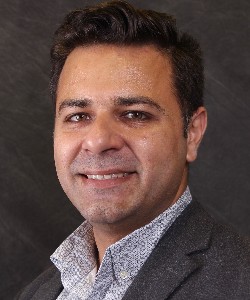Electrical Neuromodulation – Past, Present, and Future Directions
Electrical neuromodulation can be described as applying electrical stimulus to specific neurological sites to produce an effect within a corresponding area of the body.1 In the context of pain management, it refers to spinal cord stimulation (SCS) or peripheral nerve stimulation (PNS), in which stimulus is applied to either the dorsal column of the spinal cord or peripheral nerves, respectively.
With technological advancements, more potential peripheral nerve neuromodulation targets will emerge and a growing number of acute and chronic pain conditions will become treatable.
Neuromodulation techniques have been in use since the 1960s. However, recent advances have significantly improved their efficacy and broadened indications. In an ongoing opioid epidemic setting, neuromodulation represents a powerful, nonpharmacologic alternative. The Centers for Disease Control and Prevention (CDC) began collecting data on drug overdose deaths in 1999, and, in 2021, the total number of deceased eclipsed 1 million.2 In light of this tragic milestone, it is worthwhile to examine how neuromodulation has developed over the years and where it is heading in the future.
Brief History of Electrical Neuromodulation
The analgesic properties of electricity were first described in 46 AD.3 However, the modern era of neuromodulation did not begin until 1965, when Melzack and Wall introduced the gate control theory of pain.4 Their theory proposed a mechanism by which activation of non-nociceptive nerve fibers (A-β fibers) can interfere with and suppress signals from nociceptive nerve fibers (C and A-δ fibers).5 Shortly after, Sweet and Wall demonstrated that applying non-painful electrical stimulus to peripheral nerves did suppress painful sensations.6,7
The neurosurgeon Norman Shealy soon recognized that the high density of A-β fibers in the spinal cord’s dorsal column was a prime target for neurostimulation.3,4 In 1967, he implanted a prototype SCS into a patient suffering from intractable cancer pain.8 After the procedure, the patient reported profound pain relief. Given Shealy’s results, Medtronic introduced the first commercially available SCS in 1968.4
The first SCS devices consisted of two parts: an implantable epidural electrode with a subcutaneous antenna and an external control box with a battery-operated power supply and external antenna.3,4,9 With the external waveform generator powered on, the implanted electrodes received a radiofrequency signal, which resulted in stimulation of the dorsal column with tonic, low frequency, electrical pulses. These pulses induced paresthesia and analgesia in a particular body region depending on the stimulated spinal cord segment.
Technological advances resulted in smaller, less invasive SCS systems in the next few decades. In the 1970s, Medtronic introduced percutaneously inserted electrodes, significantly reducing SCS invasiveness.9,10 In 1981, advances in battery technology led to the development of the implantable pulse generator (IPG), eliminating the need for external radiofrequency (RF) signal generators.4 Soon after, fully implantable IPG-powered SCS devices became the standard of care.9 In 2004, the first rechargeable IPG was introduced, eliminating surgical replacement of the depleted battery cells.9 In the mid-2010s, the advent of PNS, new stimulation paradigms, and closed-loop feedback systems revolutionized the field.
Novel Targets for Neuromodulation
Aside from early experiments in the late 1960s, PNS was mainly neglected as a practical means of pain management, primarily due to technical limitations such as lack of minimally invasive implantation techniques and difficulties tunneling lead wires to the peripheral anatomic targets.7,11 It wasn’t until 1999 that Weiner and Reed demonstrated the real potential for PNS when they successfully treated occipital neuralgia via percutaneous occipital nerve stimulation.12 In 2016, the first randomized controlled trial (RCT) was published demonstrating the safety and efficacy of a system explicitly intended for PNS.13 It could be comfortably implanted anywhere in the periphery with only a small, implantable lead and an external power generator. Soon after, other devices intended for the peripheral nervous system followed. In 2017, a multicenter study showed dorsal root ganglion stimulation superior to the tonic, low-frequency SCS for treating complex regional pain syndrome and causalgia.14 In 2019, sphenopalatine ganglion stimulation using a microstimulator was successfully used to treat cluster headaches.15
These new devices have reoriented the field of neuromodulation away from the one-size-fits-all model of SCS and toward a more targeted, precise approach. As devices continue to decrease in size, clinicians will be empowered to precisely target any nerve of interest, regardless of anatomical location.16,17 With technological advancements, more potential peripheral nerve neuromodulation targets will emerge and a growing number of acute and chronic pain conditions will become treatable.
Advances in Stimulation Parameters
Despite years of research, the ideal SCS parameters are still being elucidated. Historically, tonic, low-frequency stimulation was the standard of care; however, that changed after the groundbreaking SENZA trial in 2015, demonstrating that high-frequency stimulation at 10 kHz was superior to traditional SCS for producing analgesia while being paresthesia-free.18 And, in 2017, the SUNBURST trial validated the superiority of the burst waveform stimulation over the tonic, low-frequency SCS.19
A recent study showed that differential targeting of the neuronal-glial interactions produced a significantly higher reduction in low-back pain than traditional SCS.20 Although all these stimulation parameters result in paresthesia-free analgesia, they all differ in the mechanisms by which they modulate nerve activity. Such findings bring into question the importance of the gate-control theory; moving forward, newer, more effective stimulation paradigms are likely to be discovered.21 Both high-frequency and low-frequency stimulation has shown promising results for central and peripheral nervous systems. Future research should identify which nerves respond best to which kind of stimulus.16,17
Advances in Hardware
Historically, IPGs were programmed to provide only one type of stimulus pattern. If a patient failed the initial therapy, surgical exchange of the IPG was required. Also, the battery life was limited. However, with the rapid improvement in neuromodulation science and technology, patients now have access to several programming options offering the same IPG with long-lasting rechargeable and non-rechargeable battery options. These advancements have enabled personalized therapy, as what works for one patient may not for another. Also, patients’ analgesic needs may change over the years based on their disease process. Upgradable stimulators are becoming the standard to accommodate the swift advancements in software and programming. Generic pulse generators customizable via the latest software updates allow the deployment of new therapies without necessitating frequent surgical replacement and significant cost reduction. Although any upgradable systems are prone to inherent risks, the benefits of such devices greatly outweigh the negatives.17,22
The Emergence of Closed-Loop Systems
Until recently, neuromodulation devices have operated via open-loop systems, which means the device delivers the same stimulus over time unless reprogrammed. However, positional changes or other occurrences throughout the day may alter the effectiveness of neurostimulation therapy. A closed-loop system can account for such disturbances, as it relies on real-time feedback to make real-time alterations as needed. The first closed-loop system was brought to market in 2011.17,23 Another closed-loop system measures evoked compound action potentials (ECAP), or the degree of A-β fiber activation achieved following a delivered stimulus. Based on the measured ECAP, the system makes real-time adjustments to achieve optimal levels of stimulation.16,17
Conclusion
Electrical neuromodulation currently is undergoing a renaissance in research and technological progress. Much like our understanding of chronic pain pathophysiology, the mechanism for analgesic neuromodulation is still partially understood. However, as the medical community continues to unfold these mysteries, neuromodulation will similarly progress in its decades-long journey toward more precise, more effective, and less invasive therapy. We are at an exciting intersection in the world of interventional pain management, and it seems like we are just getting started. It is up to us to choose the path of mediocrity or break through self-proclaimed barriers to revolutionize neuromodulation as a means to eliminate human suffering.

Bradley H. Due, MD, is a PGY-1 in the department of anesthesiology, perioperative, and pain medicine at Brigham and Women's Hospital in Boston, MA.

Muhammad A. Farooq Anwar, MD, MBA, is a pain medicine fellow in the department of anesthesiology at Duke University in Durham, NC.

Kevin Vorenkamp, MD, FASA, is an associate professor in the department of anesthesiology at Duke University in Durham, NC.
References
- Thomson S. Neuromodulation, or neuromodulatory effect. International Neuromodulation Society (2021, Nov. 21) Retrieved from https://www.neuromodulation.com/neuromodulation-defined. Accessed January 4, 2022.
- Mann B. More than a million Americans have died from overdoses during the opioid epidemic. National Public Radio (2021, Dec. 1). Retrieved from https://www.npr.org/2021/12/30/1069062738/more-than-a-million-americans-have-died-from-overdoses-during-the-opioid-epidemi. Accessed January 1, 2022.
- Alho EJL, Cordeiro JG, Monaco BA, et al. Introduction and history of neuromodulation for pain. In: Freitas TS, Monaco BA, Golovac S. Neuromodulation Techniques for Pain Treatment. 1st ed. Cham, Switzerland: Springer; 2021.
- Gildenberg PL. History of electrical neuromodulation for chronic pain. Pain Med 2006;7(Suppl 1):S7-13. https://doi.org/10.1111/j.1526-4637.2006.00118.x
- Melzack R, Wall PD. Pain mechanisms: a new theory. Science 1965;150(3699):971-9. https://doi.org/10.1126/science.150.3699.971
- Wall PD, Sweet WH. Temporary abolition of pain in man. Science 1967;155(3758):108-9. https://doi.org/10.1126/science.155.3758.108
- Ottestad E, Orlovich DS. History of peripheral nerve stimulation-update for the 21st century. Pain Med 2020;21(Suppl 1):S3-S5. https://doi.org/10.1093/pm/pnaa165
- Shealy CN, Mortimer JT, Reswick JB. Electrical inhibition of pain by stimulation of the dorsal columns: preliminary clinical report. Anesth Analg 1967;46(4):489-91.
- North RB, Prager JP. History of spinal cord stimulation. In: Krames ES, Peckham PH, Rezai AR. Neuromodulation. 2nd ed. Cambridge, MA: Academic Press; 2018.
- Erickson DL. Percutaneous trial of stimulation for patient selection for implantable stimulating devices. J Neurosurg 1975;43(4):440-4. https://doi.org/10.3171/jns.1975.43.4.0440
- Deer TR, Naidu R, Strand N, et al. A review of the bioelectronic implications of stimulation of the peripheral nervous system for chronic pain conditions. Bioelectron Med 2020;6:9. https://doi.org/10.1186/s42234-020-00045-5
- Weiner RL, Reed KL. Peripheral neurostimulation for control of intractable occipital neuralgia. Neuromodulation 1999;2(3):217-21. https://doi.org/10.1046/j.1525-1403.1999.00217.x
- Deer T, Pope J, Benyamin R, et al. Prospective, multicenter, randomized, double-blinded, partial crossover study to assess the safety and efficacy of the novel neuromodulation system in the treatment of patients with chronic pain of peripheral nerve origin. Neuromodulation 2016;19(1):91-100. https://doi.org/10.1111/ner.12381
- Deer TR, Levy RM, Kramer J, et al. Dorsal root ganglion stimulation yielded higher treatment success rate for complex regional pain syndrome and causalgia at 3 and 12 months: a randomized comparative trial. Pain 2017;158(4):669-81. https://doi.org/10.1097/j.pain.0000000000000814
- Goadsby PJ, Sahai-Srivastava S, Kezirian EJ, et al. Safety and efficacy of sphenopalatine ganglion stimulation for chronic cluster headache: a double-blind, randomised controlled trial. Lancet Neurol 2019;18(12):1081-90. https://doi.org/10.1016/S1474-4422(19)30322-9
- Isagulyan ED, Mikhailova VA, Aslakhanova KS, et al. Prospects of neuromodulation for chronic pain. Brain Disorders 2022;5:100027. https://doi.org/10.1016/j.dscb.2021.100027.
- Fishman MA, Antony A, Esposito M, et al. The evolution of neuromodulation in the treatment of chronic pain: forward-looking perspectives. Pain Med 2019;20(Suppl 1):S58-S68. https://doi.org/10.1093/pm/pnz074
- Kapural L, Yu C, Doust MW, et al. Novel 10-kHz high-frequency therapy (HF10 therapy) is superior to traditional low-frequency spinal cord stimulation for the treatment of chronic back and leg pain: the SENZA-RCT randomized controlled trial. Anesthesiology 2015;123(4):851-60. https://doi.org/10.1097/ALN.0000000000000774
- Deer T, Slavin KV, Amirdelfan K, et al. Success using neuromodulation with BURST (SUNBURST) study: results from a prospective, randomized controlled trial using a novel burst waveform. Neuromodulation 2018;21(1):56-66. https://doi.org/10.1111/ner.12698
- Fishman M, Cordner H, Justiz R, et al. Twelve-month results from multicenter, open label, randomized controlled clinical trial comparing differential target multiplexed spinal cord stimulation and traditional spinal cord stimulation in subjects with chronic intractable back pain and leg pain. Pain Pract 2021;21(8):912-23. https://doi.org/10.1111/papr.13066
- Deer TR, Jain S, Hunter C, et al. Neurostimulation for intractable chronic pain. Brain Sci 2019;9(2):23. https://doi.org/10.3390/brainsci9020023
- De Ridder D, Vanneste S. Visions on the future of medical devices in spinal cord stimulation: what medical device is needed? Expert Rev Med Devices 2016;13(3):233-42. https://doi.org/10.1586/17434440.2016.1136560
- Medtronic, Inc. Medtronic receives FDA approval of AdaptiveStimTM with RestoreSensorTM for the management of chronic pain. Business Wire 2011, Nov. 17. Available at: https://www.businesswire.com/news/home/20111117005041/en/Medtronic-Receives-FDA-Approval-of-AdaptiveStim%E2%84%A2-with-RestoreSensor%E2%84%A2-for-the-Management-of-Chronic-Pain. Accessed January 15, 2022.
Leave a commentOrder by
Newest on top Oldest on top